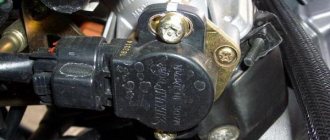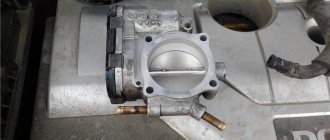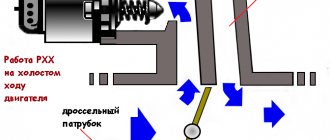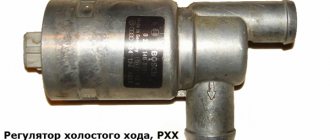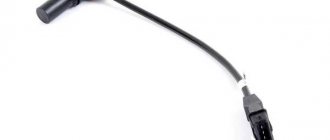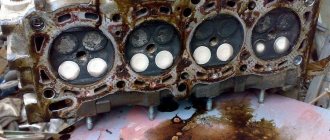Replacing the idle speed sensor on a viburnum
Welcome! Idle air sensor - scientifically it is called the idle air control (IAC), because it performs the function of adjustment, and sensors, as a rule, are needed only to read readings and give them to the controller, and these readings will be processed and configured by the car , according to the sensors that gave him readings, but the regulator precisely regulates the idle speed, that is, it interferes with the operation of the throttle valve due to its rod, which, depending on the speed of the car, either goes to a certain length, or, on the contrary, goes back, we will explain its principle work in more detail, the regulator has its own rod (indicated by number 5), when the gas pedal is not pressed (the car is idling), this rod extends to a certain length and the throttle valve closes (the valve is indicated by number 1), thereby node, a bypass channel opens (This channel is indicated by number 3), through which the main part of the air passes while the car is idling, while the controller (ECU) gives readings to the regulator, and therefore when you start the injection car in cold weather, the controller gives readings to the regulator that the engine is still cold and thus the rod of the regulator extends to a shorter length, due to which the engine speed increases and the car warms up faster, but as the engine warms up, the rod extends further and further, thereby the speed drops and fuel consumption becomes less (Engine is warm).
Note! To replace this sensor on a car, you will need: A socket with a wrench, as well as a screwdriver, and if you have a multi-meter, be sure to stock it up, because with its help you can check whether the idle air control is working or not!
Summary:
Where is the idle air control valve located? It is located on the throttle assembly and inserted into the inside of the bypass channel, what kind of channel this is we have already explained to you above, in addition, next to the IAC there is also a throttle position sensor which, by the way, is also subject to replacement from time to time, for clarity, the location of both of these The sensors can be seen in the photographs below, in both photos the IAC is indicated by a red arrow, and the damper position sensor is indicated by a blue arrow.
When should I change the idle air control valve? When incomprehensible things began to happen with the idle speed, for example, the car does not maintain speed (it stalls immediately after starting), the speed freezes when driving after releasing the gas pedal, or the engine speed decreases when various types of devices are turned on (heater, high beam and etc.), all these symptoms relate to the regulator, we will explain how this all happens, first about the fact that the car stalls, as you already understood, if no one presses the gas pedal, then the throttle valve closes almost completely (A small gap remains there, but it there is not enough air to supply the engine with air, so as a rule the car immediately stalls) and the car does not stall for only one reason, the bypass channel, if the regulator is working, then the bypass channel is open and air passes through it, if the regulator breaks and hangs in the fully open position, then this channel will already be closed and therefore the car will stall, again, if the rod of the regulator hangs in the completely closed position, then the idle speed will increase and you will drive like this until you replace it with a new one.
Note! Before changing the sensor, try to completely clean the throttle assembly; at the same time, clean the bypass channel by unscrewing the idle speed control and removing the throttle assembly completely from the car; for more information on how the assembly should be cleaned, read the article: “Cleaning the throttle assembly on a car ", sometimes cleaning the unit helps a lot and problems with speed immediately disappear from the car!
Throttle Position Sensor Repair
You can restore functionality by removing the sensor from the machine , inserting a flat-head screwdriver into the hole and making light rotational movements. This will clear deposits from the resistor track. If it doesn’t help, install a new one.
In all other respects, the Niva Chevrolet throttle sensor is not repairable . Therefore, if a malfunction is detected, it is recommended to replace it with a new one. It is preferable to install a contactless type. Although its price is much higher, the unit is more practical, unpretentious and durable.
Healthy . TPS is not subject to adjustment. The controller uses the minimum signal voltage at idle at an approved reference point.
Selection of spare parts
The non-contact throttle position sensor for the Chevrolet Niva is interchangeable with models of the tenth VAZ family, LADA Samara, LADA Kalina, LADA Priora, LADA Granta, LADA 4x4. Product code 21120-1148200-82.
Replacing TPS in Niva Chevrolet
To replace the Niva Chevrolet TPS, you will need a flathead and Phillips screwdriver. The work order is as follows :
- Pry up the rubber latches and remove the plastic casing from the engine.
- Remove the wiring block.
- Unscrew the 2 fastening screws.
- Remove the old sensor.
- Install a new one in its place .
- Tighten the screws , connect the wiring and check operation.
How to replace the idle speed control on a VAZ 1117-VAZ 1119?
Removal: 1) First, check the regulator, maybe it works and you are going to change it for a new one, this is done as we already said using a multi-meter, namely, turn off the ignition of the car (But there should be wires on the battery) and then from regulator, the block of wires is disconnected, it has a latch, you will need to press on it to remove this block and when the block is disconnected, get into the car and turn the key to turn on the ignition (This is when all the devices light up), then on the tester turn on the voltmeter function and connect the red probe coming from it to terminal “A”, and throw the black one to ground (the ground can be the engine or the throttle assembly), carry out exactly the same operation with terminals “B”, “C” and “D” ( There are only four terminals, in other words, do this with all the terminals) and if the voltmeter gives a reading of 0.4-12 V, then everything is fine with the regulator, but there is another test for resistance, do that too, this is what it means, the tester is switched to the ohmmeter function and the two wires coming from the tester are connected to two contacts “A” and “B” at once (that is, for example, connect the red wire to terminal “A”, and the black wire to “B”), exactly the same operation with terminals “C” and “D” produce a result that the tester should give about 0.040-0.080 kOhm, if it gives other readings, then change the regulator.
2) Let’s move on to removing the regulator, in fact there is nothing difficult in removing it, it’s just not located in a very convenient place and in order to get there, it is best to remove the throttle assembly from the car, otherwise you are unlikely to get to the regulator mounting screws, this one is removed the unit is very easy, you unscrew several nuts securing it and after that the unit is removed from the receiver studs, read more in the article: “Replacing the throttle unit on a car”, but you don’t need to disconnect any hoses from the fittings of the unit, just unscrew the nuts and remove it and put it (You can also hold it in your hand).
Note! In fact, the assembly doesn’t have to be completely removed, but it will simply be more convenient, but still, if you don’t want to remove it, you can slightly unscrew the nuts that secure it and move the throttle assembly along the studs from its installation location so that it comes out a little and did not stand close to the receiver!
Throttle Position Sensor - Check and Replacement
Examination
1. We prepare the car for work (see “Preparing the car for maintenance and repair”). 2. Remove the decorative trim of the engine (see “Decorative trim of the engine - removal and installation”). 3. Release the clamp of the wiring harness block and disconnect the block from the throttle position sensor.
4. Connect the negative probe of the engine voltage. 5. Turning on the ignition, connect the “positive” probe of the voltmeter to terminal A of the wiring harness block (the numbering of the terminals is marked on the block) and measure the supply voltage.
Removal
1. Using a Phillips screwdriver, unscrew the two screws securing the idle air control to the throttle body.
2. Remove the throttle position sensor from the throttle axis. The connection between the sensor and the throttle body is sealed with a foam ring.
Where is the idle speed sensor on the Lada Kalina and its replacement
Car : Lada Kalina. Asks : Ivan Vinokurov. The essence of the question : I want to replace the idle speed sensor, but I don’t know where it is located?
Good afternoon, I recently had this problem. When I stop at a traffic light, the idle speed starts to fluctuate, up and down! Friends say that the reason may be in the idle speed sensor, but I don’t know where it is located. Please tell me how to find it and how to solve my problem?
The idle speed sensor or, in other words, the idle speed regulator ( IAC ) is designed for stable engine operation when the gas pedal is released. It is this device that provides a minimum supply of air and fuel when the car is stationary and idling.
Replacing the idle air control
The design of the IAC is such that in case of any problems with the mechanical or electrical parts, the regulator must be replaced. Repair attempts help eliminate the problem for a while, but after 1–3 weeks it returns again. When purchasing a regulator, keep in mind that models for different engines are not interchangeable. Therefore, select the sensor not by engine type (the seller may make a mistake), but by the catalog number, which is indicated on the regulator body. Replacing the regulator does not cause any difficulties. Remove the old IAC as described above, then install the new one and connect the wire block.
Causes of IAC malfunction
The incorrect operation of this sensor can be determined by several criteria, and if one of them occurs in the operation of your car, you can safely start cleaning it, or buy a new one in the store. So, the most common symptoms that occur when the idle air regulator fails:
- Starting the engine is very difficult without the help of the gas pedal, or it does not start at all.
- When the car is stopped, the idle speed fluctuates.
- When changing gears, the rpm either drops to about or around this value.
- In cold weather, the engine does not reach more than 1500 rpm when cold.
- When starting up appliances, lights, stoves, heating and other devices, the speed “sags”.
- The engine speed either rises or falls spontaneously, or stops at values exceeding the norm.
So, let's figure it out and understand where this sensor is located and how to properly dismantle it.
Symptoms of malfunction
The main function of the sensor is to maintain idle speed within a given range, which allows for timely warming up of the engine. The following problems indicate regulator malfunctions:
- Difficulty starting the engine - only on the second or third attempt.
- The engine stalls when changing gears.
- When operating in neutral, “floating” speeds .
- The engine takes a long time to reach operating temperature when starting in the cold season. Here the speed immediately after starting a cold engine is low for this mode.
These speeds are low for a cold engine.
- The speed decreases after turning on the air conditioning compressor.
Replacing the idle speed sensor (video)
Dismantling the IAC
- First of all, before starting the replacement, turn off the engine and open the hood.
- The regulator itself is located on the throttle body, slightly lower than the damper position sensor.
- This photo shows how to find it visually by simply looking a little further under the hood.
The idle speed control is marked with a red marker.
We put the unscrewed screws in a safe place.
IAC inspection
- Now that the device has been dismantled, you can easily determine and decide whether to replace the sensor with a new one or start cleaning it.
- If there is carbon deposits on the regulator, but there is no mechanical damage, no parts are falling off its body, and its condition inspires confidence in you, then you can easily simply clean it.
- For this we only need carburetor cleaner and a clean rag. Using it, fill all the holes and niches, clean everything with a rag and let it dry for a certain time.
This is what a “dirty” IAC may look like.
And so after cleaning.
IAC assembly
After the device has been cleaned or replaced with a new one, we reassemble it in the same manner as removal. Do not forget to connect the wiring harness to it and check that it is securely secured.
Replacing the idle air control
To do the job you only need a shaped screwdriver. If dismantling involves removing the entire throttle assembly, you need to prepare a set of standard socket wrenches or sockets.
- First, wait until the engine has cooled down, after which you can disconnect the terminals from the battery.
- The clamps must be removed from all hoses.
- From the idle speed control and throttle position sensor, disconnect the wire chips and remove the throttle cable.
- The throttle heating hoses must be removed and plugged.
- Use a 13mm wrench to unscrew the fastening nuts, then the throttle assembly can be removed.
- Next, all that remains is to unscrew the two screws holding the idle speed control and remove it. A new IAC is installed in its place and secured with two screws.
conclusions
Attention!
After installing the new idle air control and starting the engine for the first time, the speed will rise to 2000 rpm. However, you should not be afraid of this, in this way the device is adjusted to the correct operating mode in the car and everything is corrected after the engine is turned off and started again.
Thanks a lot! Even to me, a “teapot”, everything was clear!
I would like to note that when the IAC malfunctions, several of the listed symptoms usually appear. Therefore, with only floating speeds xx, it cannot be suspected only. Floating speeds can also occur due to faulty throttle position sensors or camshaft position sensors (sometimes called a phase sensor). And even dead candles or a neutralizer can lead to the same result.
And if the engine is 8kL (i.e. there are no hydraulic compensators), then the cause of the floating idle speed may be sagging valves. More likely on cars with HBO
Replacing TPS with your own hands
The throttle position sensor on the Priora is located in the same place as on all other front-wheel drive VAZ cars. Directly on the throttle body, next to the idle air control. Symptoms of a TPS malfunction on a Priora can be different, and the main ones are listed below:
- unstable engine speed
- dips when moving
- jerks when accelerating
- no idle speed
- loss of engine power
- increased speed means the impossibility of engine braking
If your Priora has at least one of the above symptoms, then it is worth paying attention to the throttle position sensor. Fortunately, you can replace it with your own hands without any problems, and you will need the following tool for this:
- Phillips screwdriver
- Magnetic handle
Idle speed sensor Lada Kalina
The Lada Kalina idle speed sensor or IAC is a device that is responsible for the necessary air supply to the internal combustion engine when it is idling (in the absence of pressure on the gas pedal). For example, the driver releases the accelerator pedal and the air supply to the internal combustion engine stops. To prevent the engine from stalling, the idle speed sensor comes into operation, which is involved in the process of supplying the required amount of air bypassing the throttle assembly.
In other words, the IAC is a kind of valve-regulator. It is very important for every car owner to know and understand the principles of operation of the product, because if it breaks down, in most cases the car’s self-diagnosis system does not determine the reason for the incorrect operation of the engine.
Diagnostics of the idle speed sensor
The regulator is installed on the throttle valve block, immediately below (TPS). This arrangement is the same on all VAZ models, from the injection classics to the Granta and Vesta. The reasons for checking the regulator are different - floating idle speed, the engine stalls in neutral gear or sharply picks up or drops speed for no reason, while the on-board computer does not show a malfunction of the TPS. Many people ask where the idle speed sensor is located; the answer to this question is in the diagram below.
Check the IAC only with the engine turned off. The verification is carried out in four stages:
- Checking engine operation. It is necessary to determine whether the problem extends to other engine operating modes. The optimal way to do this check is to quickly accelerate the car on a testing ground or an empty stretch of road without a speed limit. If the car has not lost its dynamics, then the problem is in the IAC. If the car begins to accelerate worse, it is necessary to carry out a comprehensive check of the engine.
- After making sure that the problem is in the IAC, you need to check the power circuit. To do this, you need to remove the block with wires from the sensor. On 1.6-liter engines, this will require unscrewing two bolts and moving the throttle body away from the receiver. With the ignition turned on, measure the voltage first at pins A and B, then at C and D. The voltage should be over 12 volts. If there is no voltage, or it is noticeably less, it is necessary to carry out serious diagnostics of the wiring, for which it is advisable to contact an experienced auto electrician.
- After making sure that the problem is in the IAC, you need to remove it from the engine, which will require unscrewing two bolts. On some VAZ models, the IAC is mounted on varnish, so you will have to remove the throttle valve block (at the same time you can check and clean it) and remove the regulator from it. After removing the IAC, measure the resistance on contacts A and B, then on C and D. It should be 50 - 80 Ohms. After this, measure the resistance between A and C, then B and D. It should be at least 15 megaohms. If the resistance does not match, it is advisable to replace the regulator, because the problem is in the coils of the electromagnet that controls the needle. Also carefully inspect the contacts on the sensor and block. If there is even a slight suspicion of dirt or oxides, treat them with contact cleaner (spray), then dry with compressed air.
- After making sure that the contacts and resistance of the sensor are in order, proceed to check the functionality. Insert the block into the sensor connector, turn on the ignition and lightly press your finger against the tip of the IAC needle. Ask an assistant to turn off the ignition. If the sensor is working properly, you will feel a prick, and the needle will come out of the body by at least 5 mm. Turn the ignition on and off several times to make sure the adjuster moves the needle in and out completely.
Idle speed regulator Lada Kalina and its device
- a housing in which a stepper motor is located with two windings independent of each other, rotor supports (rear and front);
- valve shut-off needle and spring;
- power connector.
3 main functions of the controller
1. In addition to maintaining the required engine speed, the device ensures its proper operation under cold start conditions (warming up at sub-zero air temperatures). In this case, the regulator provides higher engine speeds until the latter warms up to operating temperature. 2. The second important function that many drivers don’t even think about is the speed maintenance mode without pressing the gas pedal. In other words, ensuring the engine operates at idle speed is the merit of the IAC. 3. The third and very important purpose of the product is to ensure the creation of an air-fuel mixture of the required concentration and saturation. This feature has a positive effect on final fuel consumption and smooth engine operation.
TPS for Lada Priora
The Lada Priora VAZ 2170 is also equipped with a special sensor that reads the throttle position and transmits data to the electronic control unit (ECU). This element is a potentiometer. On the one hand, there is a “plus” on it, and on the other, a corresponding “minus”, formed by connecting to the “mass”. From the remaining last output there is a wire connecting the TPS and the ECU.
Data transfer occurs as follows. At the moment of changing the position of the damper (in turn formed as a result of pressure on the accelerator pedal), the transmitted voltage changes. The greater the pressure on the control pedal, the more the indicated value increases. When the damper is completely closed, the voltage is approximately below 0.5 V. When the damper is fully open, this level exceeds 4.5 V.
Constantly changing data is instantly transmitted to the electronic control unit, which, referring to the received data, controls the fuel supply level. Idle speed is taken as the reference point.
In cases where the sensor stops transmitting signals for some reason, the ECU remembers the code. It indicates a breakdown or problem that has arisen with this sensor. The driver becomes aware of a malfunction when the “CHECK” light comes on on the instrument panel.
Since in such a case it is not possible to read accurate information from the TPS, the calculation of the angle of rotation of the throttle valve on the Priora is based on the crankshaft speed and the signal from the mass air flow sensor (MAF).
Where is the idle speed sensor on Kalina
Due to its purpose, the product is located directly in the throttle assembly next to the throttle position sensor.
Signs indicating malfunctions
Some signs indicating improper operation of the unit: - problems with starting the engine (it is possible to start only by repeatedly pressing the gas pedal); — floating speed when switching gears to neutral; — when changing gears, the car stalls completely or choke; — it is difficult to warm up the engine in the cold season (engine speed does not increase above 1500 rpm); — when additional energy consumers are turned on (stove, air conditioning, heating and others), the idle speed is lower than the operating values, or constantly floats.
If you observe one or more of the above situations, pay attention to the idle speed sensor for the 8 valve Kalina and carry out diagnostic measures.
Signs and causes of malfunction
Incorrect operation of the Niva Chevrolet throttle position sensor is manifested in the following symptoms:
- unstable, sometimes completely absent idle, floating speed;
- dips and jerks while driving;
- reduction in engine dynamics and power;
- increased fuel consumption;
- The Check Engine light is on, and when scanning, a code p0120 or another code associated with the TPS appears.
Advice . These reasons are not a guarantee of an identified breakdown and may indicate a malfunction of the throttle valve, lambda probe, or fuel pump.
Causes of malfunction of contact TPS of Niva Chevrolet:
- Poor or no contact between the slider and the track . Occurs due to normal wear or broken tip. Sometimes the resistive layer wears off.
- In the place from which the slider begins its movement, the sprayed base is erased . In this case, the linear output voltage will be constantly low or unstable.
- Worn slider drive gears .
- Broken wiring.
- Short circuit in the electrical circuit of the TPS.
Examination
3 popular ways to diagnose the causes of a malfunction
Among professionals and car enthusiasts, there are many ways to check the performance of the sensor. But we will dwell in detail only on the most effective and simple methods:
- First method. The point of this method is to check the operation of the sensor itself. To do this, you need to remove the product from its mounting location, take it in your hand, connect the power contact block to it (if it is not connected) and start the car engine. In this case, on a working device, when the engine starts, the sensor needle should extend. If this does not happen, then its operation is impaired or the device is faulty.
- Second method. Assumes the use of a voltmeter. The task is to check that the correct voltage is supplied to the sensor. To do this, the sensor is disconnected from the contact chip, and a measuring device is connected to its terminals. After which, the ignition is turned on, and all the terminals of the contact chip are analyzed one by one. The operating resistance parameters should be about fifty ohms or tend to infinity. The voltage level should be 12 volts. If the voltage reading is less, this indicates improper operation of the battery or the cause is related to an open circuit or operation of the computer.
- The third approach involves checking the resistance of the external and internal windings of the sensor. Measuring work should be done using a multimeter. The contact parameters after measurements should be in the range from 40 to 80 Ohms. If there is a deviation or zero values of the device during measurements, the IAC must be replaced.
Purpose of the design of the throttle position sensor of a VAZ car
The throttle position sensor (TPS) detects the throttle angle mechanically and converts it into an electrical signal. The data enters the car's electronic brain for processing.
Important! Without this device, engine operation goes out of normal mode. In fact, the car is impossible to use. Although you can get to the repair site under your own power: the engine will not stall.
The simplest sensor is a variable resistor that changes resistance when its axis is rotated. This design is easy to manufacture, inexpensive and is actively used on VAZ cars. However, it has a serious drawback: the material on the working track of the resistor wears out over time, causing the device to break down. Car owners try not to use such devices; the purchase can only be associated with one-time cost savings.
Non-contact sensors, which do not have friction units in the electrical part, are more popular. Only the rotation axis wears out, but the wear is insignificant. It is these sensors that are installed on most modern engines of the VAZ 2114 series and the “tens” that preceded them.
Despite the overall reliability, the unit may fail.
Replacing the idle speed sensor on Kalina
The operation of installing or removing the product is not particularly difficult and is accessible to any car owner, regardless of the level of training, under almost any conditions. Replacement is carried out in the following sequence: 1. First step. During any work related to the vehicle's electrical system, the on-board system is de-energized (to do this, simply disconnect the battery terminal). 2. Second step. We find the regulator and disconnect the contact block with the supply wires from its body. 3. Third step. Using a long Phillips screwdriver, unscrew the mounting screws (2 pieces) and remove the product from the car’s throttle body. 4. We install the new product, the procedure is similar to the removal process only in reverse order. The new sensor does not require adjustment or configuration.
Measures to extend the service life of IACs
It should be noted that it is not always necessary to immediately replace the idle air regulator for an 8-valve Kalina with a new device. Quite often, its proper operation is prevented by banal contamination with oils and tar deposits contained in crankcase gases. Therefore, to restore the performance of the IAC and extend its service life, it is necessary to periodically clean the cone needle and the spring of the product from contamination. In addition, the installation hole itself in the throttle assembly must be cleaned. If you follow the above recommendations, the device will not fail at the most crucial moment and will last for a long time.
Replacing TPS on Priora
The throttle position sensor in a Priora with a 16-valve engine is not a highly reliable unit, so every owner of this car has probably faced the need to replace this auto part. Some car owners even have a new, working TPS in stock.
Let's consider how this element is replaced. This procedure is carried out in three main steps: dismantling the old device, installing a new TPS, resetting the error about the malfunction remaining in the ECU memory from the previous sensor. In more detail, the whole process goes like this:
- Check that the ignition is turned off.
- Disconnect the connector.
- Unscrew the fastening screws with a screwdriver.
- Installation of a new device by turning a working TPS until the holes coincide.
- Tighten the screws.
- Put on the chip.
The error is reset by removing the terminals from the battery for a long period (all night). This time should be enough to completely reset the memory.
It should be noted that the Lada Priora does not require TPS adjustment, while on many foreign brands such a procedure is mandatory. If there is a need to replace this sensor, then you should not buy the cheapest one, which costs around 300 rubles.
The best solution would be to take the average (500–1000 rubles) or expensive option (1000 and above), if possible. Thus, the likelihood that you will no longer be bothered by the TPS will increase significantly.
Checking and replacing the idle speed sensor Lada Kalina
If “floating” speed appears on your Lada Kalina, then you definitely need to check the idle speed sensor. Among all engine problems, incorrect idle speed can occur in the following cases:
- The engine stalls when changing gears.
- The engine speed increases or decreases independently.
- When stopping the car with the engine running, the speed drops sharply.
All of these symptoms indicate a faulty idle speed sensor. But before you start repairing it, you need to know exactly where it is and what it looks like.
Replacement procedure
Replacement is carried out in the following order:
- We de-energize the on-board system by removing the negative terminal, which is located on the battery;
- Disconnect the block from the sensor. For a VAZ injector this happens by pressing a plastic latch;
- We unscrew two screws, and it is recommended to first unscrew the left fastener, then the right one;
- Now the regulator has been removed and there is no problem in replacing it with a new one;
- Before installation, it is advisable to spread oil on the sealing ring. See if there are even the slightest cracks on the ring, in which case it needs to be replaced;
- There is also no difficulty in the calibration procedure; the electronic relay will do everything. You just need to turn on the ignition for a few minutes and then turn it off. After this, the speed usually no longer fluctuates, and the car works without failures.
Asks
: Vinokurov Ivan.
The essence of the question
: I want to replace the idle speed sensor, but I don’t know where it is located?
Good afternoon, I recently had this problem. When I stop at a traffic light, ! Friends say that the reason may be in the idle speed sensor, but I don’t know where it is located. Please tell me how to find it and how to solve my problem?
Idle speed sensor or, in other words, idle speed regulator ( IAC)
– approx.) is designed for stable engine operation when the gas pedal is released. It is this device that provides a minimum supply of air and fuel when the car is stationary and idling.
The following two tabs change content below.
I own a Renault Megane 2, before that there were Citroens and Peugeots. I work in the service area of a dealership, so I know the car inside and out. You can always contact me for advice.
The incorrect operation of this sensor can be determined by several criteria, and if one of them occurs in the operation of your car, you can safely start cleaning it, or buy a new one in the store. So, the most common symptoms that occur when the idle air regulator fails:
- Starting the engine is very difficult without the help of the gas pedal, or.
- When the car is stopped, the idle speed fluctuates.
- When changing gears, the rpm either drops to about or around this value.
- In cold weather, the engine does not reach more than 1500 rpm when cold.
- When starting up appliances, lights, stoves, heating and other devices, the speed “sags”.
- The engine speed either rises or falls spontaneously, or stops at values exceeding the norm.
So, let's figure it out and understand where this sensor is located and how to properly dismantle it.
Symptoms of a problem
Symptoms of IAC malfunction on a Lada Kalina car are as follows:
- the engine does not idle. In this case, the idle speed may jump, freeze, and then return to normal again;
- the engine idles;
- there is no compensation for the increased load on the engine;
- Difficulty starting the engine. If pressing the gas makes starting easier, then this is a sure sign of an IAC malfunction;
- insufficient or no warm-up speeds are maintained;
- The car stalls at idle, when releasing the gas, or changing gears.
Signs of IAC malfunction
Among the signs that directly or indirectly indicate incorrect operation of the idle speed sensor are the following:
- the engine does not start well - it becomes impossible to start the engine without pressing the gas pedal;
- when switching to neutral gear, “dips” in speed and their instability are observed;
- when changing gears, the speed drops or the engine stalls completely;
- the engine does not warm up well at low temperatures, since increased speeds (1500 rpm) are not reached;
- after turning on energy consumers (high beams, heater, air conditioner), the speed begins to “sag” or “float”;
- The engine spontaneously increases and decreases speed.
The IAC cannot be repaired; the device must be replaced. Before changing the idle air regulator, it is advisable to flush the throttle assembly.
Diagnostics
Have you noticed the above “symptoms”? Make sure that it is a faulty sensor that is causing the problem. If you have a voltmeter among the tools, you can carry out the diagnostics yourself.
Checking the circuit
Before checking the circuit, prepare a multimeter in advance and set it up to work. Next, open the hood and disconnect power from the idle air control. Then you need to set the voltmeter operating mode on the multimeter. The black probe needs to be connected to the ground of the car, and the red one is connected one by one to all the terminals on the block.
TPS malfunctions on Priora
There are many different points that indicate possible problems with the throttle position sensor on the Priora. The main characteristic symptoms include:
- unstable idle speed;
- dips, jerking and unpredictable movements when accelerating;
- reduction in car dynamics and power;
- increase in fuel consumption;
- stalling engine.
Particular attention should be paid to the TPS if several of the listed points are being fulfilled at once. The easiest way to diagnose the sensor is to replace it with a new one. This element is extremely inexpensive, so buying a new one and installing it on the car will not be expensive.
However, it may turn out that the problem is not a faulty auto part, but the quality of the connections. To check the supply of stable power, you should disconnect the chip and measure the indicators with a multimeter.
This procedure must be done with the ignition on. If everything is fine with the power supply, then you need to carefully inspect the device again. A common failure is the loss of contact between the slider and the resistive layer.
Preparing to clean the idle speed sensor
In order to clean the IAC, you need to prepare in advance a small set of tools and materials that will be needed during the work: a small Phillips screwdriver, aerosol liquid, rags and carburetor cleaner.
After everything necessary for work has been prepared, you need to turn off the power to the car from the battery. Next, you should find the IAC located on the throttle assembly and use a small screwdriver to unscrew the two fixing screws.
IAC cleaning
Place the idle speed sensor on a clean rag and spray the idle speed sensor needle with cleaning fluid from an aerosol can. While spraying, be careful not to get any liquid under the spring. If this happens, you will need to purge the sensor under high pressure, but this procedure will not guarantee that the IAC will work correctly. Next, wipe the needle with a clean piece of rags and wait until it dries completely.
Idle speed sensor on Lada Kalina - the photo shows the cleaning process
If this is not done, you will subsequently have to dry and clean the car spark plugs. Use engine oil and wipe the idle speed sensor O-ring. After that, install it in the seat and securely fasten it with two screws.
When installing the sensor, care must be taken, since the IAC will not operate normally with a damaged seal. If after cleaning the idle speed sensor does not want to function normally, it must be replaced with a new one.
TPS on Priora
Modern cars are controlled and controlled by an on-board computer. The Lada Priora model line was no exception, the central control device of which is the ECU (electronic control unit). When controlling the engine from a computer, the latter needs to receive the most up-to-date information from numerous sensors located in the engine compartment and other places of the car. One of these important elements is the throttle position sensor or Priora TPS.
The importance of this element is due to its purpose - calculating the position of the damper at the current time.
When you press the gas pedal (connected to the throttle assembly using a special cable), the throttle opens exactly as much as you apply pressure. At the same time, the amount of fuel supplied to the cylinders also depends on the degree of pressure. In order for the ECU to calculate the amount of gasoline to supply, it queries the TPS, which records the required data.
Sensor selection and price
This element is not very expensive, but at the same time it is not cheap. Its price depends primarily on the manufacturer. And especially, the price tags began to differ due to the growth of the dollar exchange rate.
- KZTA 573 rub.
- Omega 639 rub.
- AvtoVAZ 695 rub.
- GM 1074 rub.
There are several other manufacturers, but there is no point in listing them, since the average price range is, in principle, understandable. If you have any questions about replacing, removing or installing the IAC on a Priora, please discuss it below in the comments.
Step-by-step replacement instructions
- Using a Phillips screwdriver, remove the two screws securing the idle air control valve to the throttle body.
- Removing the idle air control
- Using an ohmmeter we measure the resistance between the terminals of the windings.
- Using a caliper with a depth gauge, we measure the protrusion of the new valve needle.
- If the valve protrusion is more than 23 mm, recess the valve into the body as follows:
- We connect the positive terminal of the battery with a wire to terminal D of the regulator (the connection of the wire to the terminal must be insulated);
- With the bare end of the wire connected to the negative terminal of the battery, briefly touch terminal C of the harness block. Since the valve moves very slowly, we touch it repeatedly, reproducing the operation of a switching power supply.
- Visually check the condition of the o-ring. We replace the damaged ring.
Install the regulator in reverse order
Replacing the sensor
Like any other vehicle electronics component, the throttle sensor is changed when the negative terminal of the battery is reset. A Phillips head screwdriver is sufficient for removal. Disconnect the connector and unscrew the fastening screws.
We remove the sensor and clean the docking area with a dry cloth. If necessary, apply a little grease to the throttle axis. Then we install a new sensor, put on the connector and connect the battery.
Important! After replacing the sensor, you need to start the engine and let it idle for a while.
After this, gradually add speed several times without moving the car. The electronic control unit (ECU) must adapt to the new sensor. Then we operate the machine as normal.
